By Eric Vandenbroeck
A make or break battle for Aleppo City has started whereby Rebel forces
smashed through regime lines in order to try and break the siege of Aleppo
City.
Government forces and their allies recently cut off the main supply
lines to rebel-held areas in the city, ostensibly beginning a siege that
endangers the lives of the hundreds of thousands of people who live there. The
city, a commercial and cultural hub before the war began more than five years
ago, has long been prized by all sides in the conflict. Were they to force
rebel fighters from Aleppo city, pro-government troops would deal a substantial
blow to the rebel cause in the war. Now, with fighting intensifying around the
city, high numbers of civilian casualties seem increasingly likely. Airstrikes
by the Syrian government and Russia continue to pound the city and surrounding
countryside. The battle for Aleppo is critical for both the Damascus regime and
the forces seeking to overthrow it.
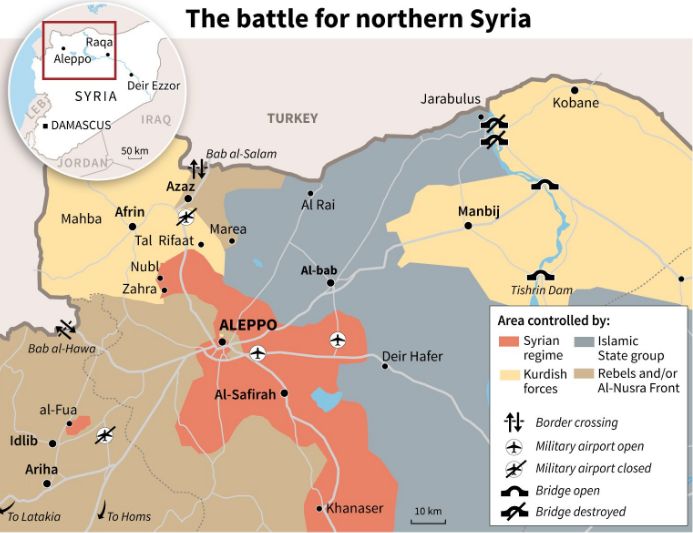
More than any single factor, it was Russia’s entry into the civil war
that enabled the regime’s latest success in Aleppo – especially Russian air
power, artillery and military advice. Once Russia had neutralized the immediate
threat to the regime’s heartland early in its intervention, rebel-held Aleppo
and its supply lines became Russia’s main targets. Iran also heavily committed
proxies to battles around Aleppo in a clear reflection of its strategic
priorities. However, the groundwork for the rebels’ encirclement was actually
done in February 2016. At this point it became clear that Aleppo’s insurgents
faced obstacles they could manage one at a time, but not simultaneously.
Iranian-backed militias including Hezbollah, Iraqi Shiite militias and local
National Defense Forces helped compensate for the regime’s serious manpower
shortages. Russian air power, while crude, brought to bear an unprecedented
amount of firepower, destroying entire rebel neighborhoods and placing
unsustainable pressure on the civilian population.
The major achievement of the February offensive was severing an
important rebel supply line through the Azaz corridor, which left the Aleppo
rebels dependent on the vulnerable Castello Road. This might have been
impossible without the role of a third party that received little mention in
official U.S. circles: the U.S.-supported Kurdish Democratic Union Party (PYD)
and its armed wing, the People’s Protection Units (YPG). As the regime
progressed amid Russian airstrikes on rebel positions, the YPG moved against
several insurgent areas, including some that were under regime and Russian
attack at the time. At some points, Russia apparently provided Kurdish forces
with air support, though this is difficult to confirm. YPG forces also attacked
Castello Road.
Of course, none of this military activity happened in a strategic or
international vacuum. The 2016 war for Aleppo has been interesting because it
has forced foreign and local powers to fully reveal their intentions and
capabilities in Syria. These many players included the U.S., Russia, Iran, the
Arab states, Turkey, the rebellion, the regime and the PYD.
By backing the successful February operation but quickly moving to
secure the cessation of hostilities (CoH) and a diplomatic process that favored
Assad, Russia indicated its eagerness to translate military gains into
political outcomes that kept its ally in power. Things have since grown more
complicated for Russia: The insurgents are not yet weak enough to agree to
these terms, and Assad has no interest in making even the minimal concessions
required to keep negotiations in progress. Aleppo’s encirclement, however,
together with Russia’s continuing military support, shows that Russia is ready
to use force to achieve its political aims, one of which is to break the
insurgency’s will and ability to seriously threaten Assad. On the other hand,
Russia’s occasional cooperation with and statements of support for Kurdish
forces show it is uninterested in restoring the territorial integrity of prewar
Syria. Aleppo shows the Russian and regime positions are different, but not
that different.
The intentions of Iran and the regime were the clearest on display in
Aleppo. The two appeared very closely aligned on the civil war and how to fight
it. Both Iran and Assad continue to believe in a military solution to the war,
even if this necessitates fighting battles they cannot win without Russian
support. Perhaps they calculate that when regime forces are under imminent
threat, Russia will ultimately step in to help rather than suffer a humiliating
loss by proxy. The Aleppo campaign followed months of Iranian and regime
violations of the Russian-backed CoH, and retained its maximalist aim of
besieging and capturing the city. The author’s conversations with Iranian
officials and Iranian-allied militias confirm their confidence in the war’s
winnability. If the Aleppo siege holds, it will embolden them further.
The U.S. position on Aleppo has sometimes seemed ambiguous over the
years, but in reality it is quite clear. Before Russia entered the war, this
author’s conversations with U.S. and European officials about Aleppo revealed
their confidence that the regime could not encircle, still less take, the city.
That may have been true until Russia entered the war in October 2015, but both
the February 2016 offensive and Aleppo’s encirclement indicate the U.S. either
did not adjust its calculations, or found the city’s fall acceptable. Seeing as
U.S. policy in Syria, apart from Secretary Kerry’s diplomatic efforts, has
effectively been subsumed under its counterterrorism policy, and that the
groups best placed to break the siege are hardline Islamists, the U.S. is likely
to do little to lift the siege on Aleppo.
The immediate losers from Aleppo’s encirclement – other than the
insurgents and local population – are the insurgency’s Arab backers and, more
importantly, Turkey. For years Turkey has worked with and built up insurgent
groups in Aleppo province, including allies of convenience as well as
ideologically sympathetic groups. The Azaz supply line that collapsed in
February 2016 was a Turkish one, and Aleppo’s insurgency is a tool against both
Assad and Kurdish expansion. As Aleppo was encircled over several months,
Turkey’s response was limited to shelling areas the YPG had captured from
rebels, to little effect. Aleppo’s story is therefore also one of Turkish
failures in Syria. It remains to be seen whether recent political turmoil in
Turkey will embolden or restrain it from acting in Aleppo.
Ironically, the only parties showing creativity and adaptability in
Aleppo are the beleaguered rebels themselves, who are trying to break the siege
from inside and outside the city. The most powerful component of this insurgent
alliance is Jaish al-Fatah, a coalition dominated by the hardline Salafist
groups Ahrar al-Sham and Jabhat Fatah al-Sham – until recently known as the
al-Qaida-affiliated Nusra Front. These groups have combined military
performance with a grasp of local sentiment, emerging as the insurgency’s
vanguard in Aleppo. Should they successfully break the regime’s siege, these
hardliners may well be the real winners of the battle for Aleppo. Their victory
would boost the depressed position of their Turkish and Arab backers and
embarrass the U.S. Alternatively, the siege may endure, which would simply
highlight U.S. failures in Syria. Regardless, these rebels’ local prestige and
goodwill as the main anti-regime force amid Western disengagement will sustain
them for now, in Aleppo and beyond.
The opposition fighters' current campaign is their last ditch attempt to
keep Aleppo as government forces attempt to further besiege rebel-held
neighborhoods.
Underneath
the rebel groups involved with the various operations in and around Aleppo.
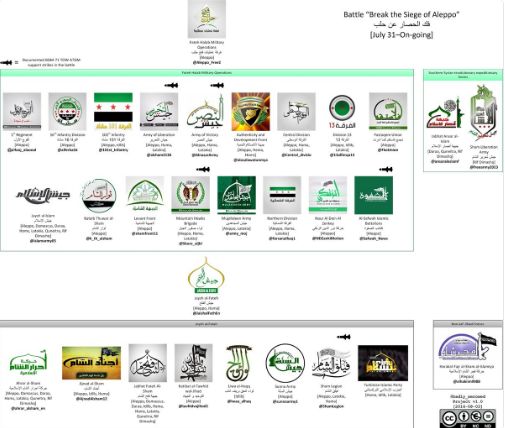
Last week, the last routes out of rebel-held eastern Aleppo were closed,
with between 40,000 and 300,000 rebels and civilians trapped within. There, they were faced with a stark choice: surrender
or starve. To further this, Russia opened up a number of so-called ‘humanitarian
corridors’, to allow civilians to safely flee, and rebels to surrender.
Standing in their way was a roughly 5km stretch of regime-held territory
featuring a large number of dug-in defenses, fortified former apartments and
the Aleppo Artillery School. Should these formidable defenses be overcome, the
rebels would be able to achieve a significant strategic victory and completely
turn the tide of the battle for Syria’s largest city. However to achieve this
would require one of the largest and most cohesive rebel offensives ever
undertaken in the war.
By creating a "smoke curtain" they
hope to impede visibility from warplanes that have been carrying out bombing
raids.
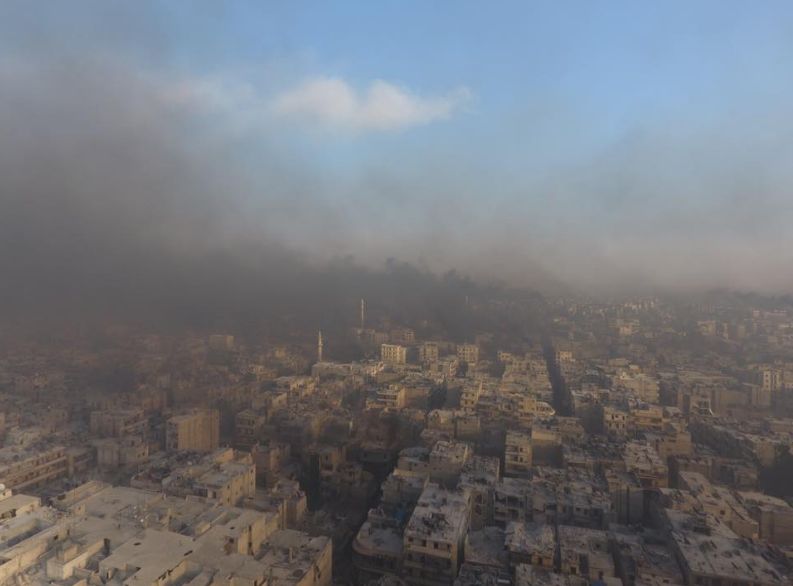
On the afternoon of July 31, the offensive began. Leading the way were
two massive armored VBIEDs which detonated and largely destroyed a regime-held
former school. This was followed by a combined-arms offensive involving
numerous tanks, APCs, technicals and infantry, which
rapidly overcame several lines of dug in regime forces. These advances were
filmed using small drone aircraft, which as well as being useful for
propaganda, can also be used for real time aerial surveillance.
Underneath suicide car bombs blasts used to
launch new Aleppo offensive.
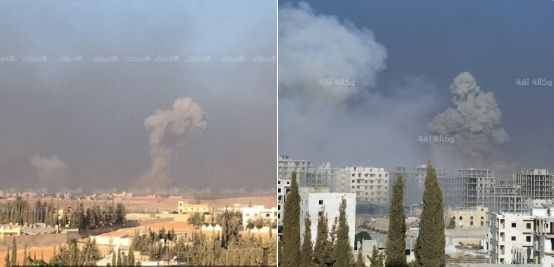
Within hours dozens of casualties were inflicted on both sides as the
battle escalated to unprecedented proportions. Hundreds of airstrikes hit
advancing rebel fighters while artillery
pounded Syrian Arab Army (henceforth SAA) forces. The clashes were huge
resulting in many SAA armored vehicles taken out. Multiple videos had emerged
showcasing dead soldiers and others running from advancing rebel armor. This
had contributed to the frenzy on social media with many claiming the siege was
only meters away from being lifted.
Contradicting reports on the
ground continued to emerge as both sides were claiming to be winning.
The rebels were now seen to be about 2.5km away from breaking the siege.
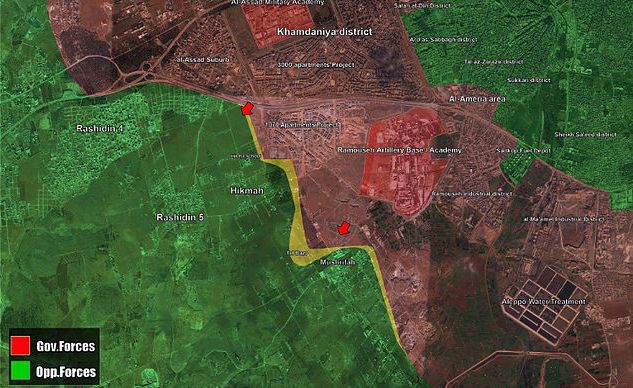
Today however the SAA backed by reinforcements from Northern Aleppo, had
countered and recaptured many sites and hills taken earlier inflicting dozens
of casualties on rebel factions.The rebels had
expected to have accomplished more by now and are irritated at the lack of
progress and loss of men and armor. This has spurred rebel factions to announce
the next phase, which is thought to be one of the final phases in the battle to
break the siege on Eastern Aleppo.
Rebels claim to have breached regime
defensive lines and captured territory shown in blue:
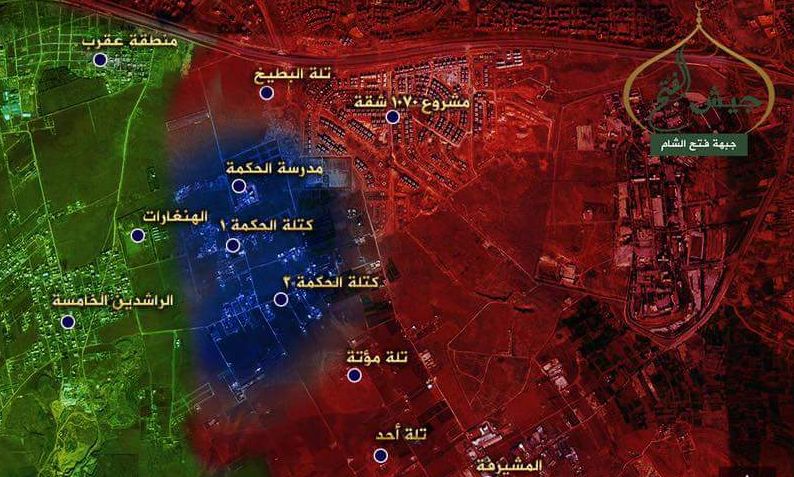
Concurrent to the main battle within Southern Aleppo, rebels groups in
other parts of Aleppo launched their own assaults and shelled regime held-areas
of the city, reportedly causing civilian casualties. At least some of these
attacks were directed against regime positions in the south of the city, so as
to force them to defend from both sides.
Residents start fires for a second day in the
Syrian city of Aleppo on August 1, in hopes the smoke would obscure the vision
of pilots bombing from overhead.
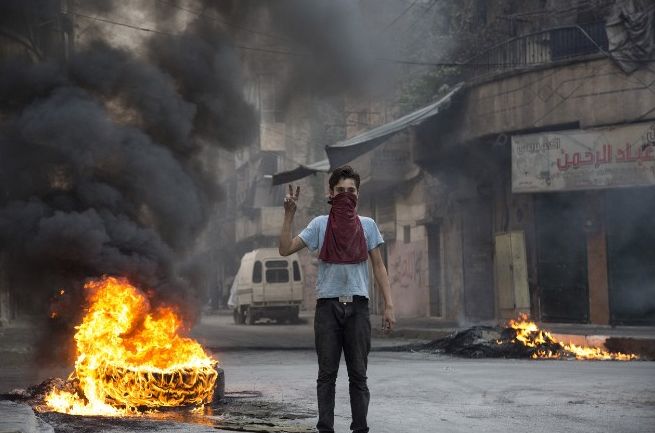
Meanwhile, relentless joint Russian/Syrian airstrikes. pummel Islamist
rebels in Aleppo outskirts that any time threatens to undo gains the rebels
made. This has slowed the offensive and allowed regime troops to retake several
positions that rebels had taken earlier on Monday leading the rebels to move on
to phase 3 of 6.
The new "phase 3" is ongoing but is already described as a
failure. One can only wait and observe as the grand battle of Aleppo continues
to unfold.
This battle, which is almost unprecedented in scale, thus is now very
much ‘do or die’ for the rebels. Given the huge amounts of manpower and
materiel they have committed to the offensive, the aftermath of a defeat would
be truly disastrous. Furthermore, the morale loss from a failed operation would
all-but preclude any future offensives on this scale for a significant period
of time.
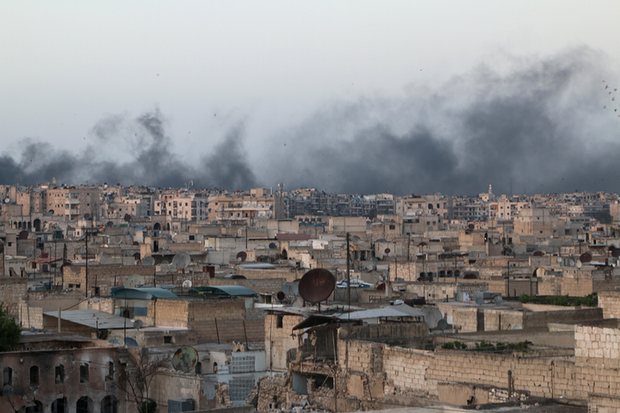
Rebel fighters want to gain control of Ramussa
district to cut off government forces and open up a new route for rebel
fighters.
Update 3
August 2016: Various Jihadist militant groups launched a new round of their attempt
to lift the size of Aleppo city. Heavy clashes erupted in Old Aleppo district,
the 1070 housing project, the sawmill, and the electrical station. However,
rebel forces were not able to breach the Syrian Army’s defense. Today Jihadist
commanders halted the Aleppo offensive to
redraw plans.
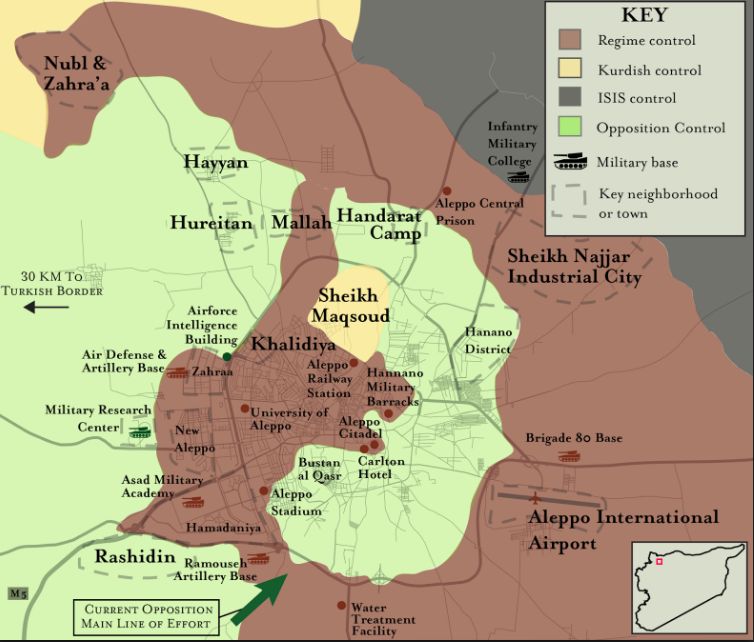
For updates
click homepage here